RFC Netheravon, Wiltshire 1913 to 1918

Information
RFC Netheravon, Wiltshire 1913 to 1918
Details
One of the oldest operational aerodromes still in military hands. Flying started here around 1911 with the Royal Flying Corps and continues to this day as a Forward Operating Base and Joint Services Parachute Centre.

Be 1914.

Be June 1914.

Short Horn 1916.
RFC Netheravon, Wiltshire 1913 to 1918
Information
RFC Netheravon, Wiltshire 1913 to 1918
Details
RFC Netheravon, Wiltshire 1913 to 1918

June 1914
Information
RFC Netheravon, Wiltshire 1913 to 1918
Officers
Details
Officers at the Netheravon Concentration outside the Officers Mess June 1914.
June 1914 the whole of the RFC came together at the RFC Concentration. They trained, played, planed, tested and just grew as a group for a month & then went back to their respective Aerodromes. 12 August and Britain declarers War and all squadrons mobilised and moved via Dover (Swingate) to France and that is another stoty.
RFC Netheravon, Wiltshire 1913 to 1918

1917
Information
RFC Netheravon, Wiltshire 1913 to 1918
Map Salisbury Plain
Details
How Lark Hill, Upavon & Netheravon fit into the Salisbury Plain Training area.
13 April 1912 a White Paper published amalgamating the Military and Naval Aeronautical Services. By special permission of King George V the new service was constituted by Royal Warrant and 'in consideration of the specially difficult and arduous nature of the flying service', was to be known as the Royal Flying Corps. [Baptism of Fire]
No.3 Squadron moved from
Lark Hill to Netheravon on the 16th June 1913 with several different types of aeroplanes.

Bleriots of No.3 Sqn RFC No.374.

B.E.2 No.240.

Henri Farmen Short Horn.

Avro 500.
RFC Netheravon, Wiltshire 1913 to 1918

1910 Lark Hill
Information
RFC Netheravon, Wiltshire 1913 to 1918
Lark Hill
Details
This was No.3 Sqn aircraft sheds at Lark Hill. It was not until the large Infantry camp was built later that the name changed to Larkhill.

Larkhill Army camp.

Larkhill Army camp.
RFC Netheravon, Wiltshire 1913 to 1918

1910 Lark Hill
Information
RFC Netheravon, Wiltshire 1913 to 1918
Lark Hill
Details
Early flying at Lark Hill.

-
Cody team fitting a propeller.

Cody.

Farman.
RFC Netheravon, Wiltshire 1913 to 1918

Lark Hill MAC
Information
RFC Netheravon, Wiltshire 1913 to 1918
Details
Prevost and his observer in the French Deperdussin, just landed in the ploughed field test in the Army competitions at the Military Aeroplane Competition July 1912.

Bristol Gordon No.12.

Deperdussin monoplane No.21

Farman Longhorn No.22
RFC Netheravon, Wiltshire 1913 to 1918

1912 Bennett Lark
Information
RFC Netheravon, Wiltshire 1913 to 1918
Lark Hill
Details
No 3 Squadron RFC. The accommodation of the Officers & men was very spread out and not really acceptable, so they moved into Netheravon as soon as they could.

Bustard Inn was the Officers Mess for Lark Hill RFC camp.

Cavalry School Netheravon riding school building was used as the men's accommodation.
RFC Netheravon, Wiltshire 1913 to 1918

Cavalry School Netheravon 1911 Fuller (pos. at Lark Hill). Fuller.
Information
RFC Netheravon, Wiltshire 1913 to 1918
Lark Hill
Details
Cavalry from the School at Netheravon visiting the flyers..

Cavalry School Officers Mess.

Cavalry School Officers Mess Netheravon.
RFC Netheravon, Wiltshire 1913 to 1918

Plan1913
Information
RFC Netheravon, Wiltshire 1913 to 1918
RFC Netheravon
Plan
Details
1913 Plan of RFC Netheravon. Red are the Officers Mess & Quarters, Yellow The Sergeants and Men's Quarters and white are the aircraft sheds.
RFC Netheravon, Wiltshire 1913 to 1918

Possibly Chivers Men from Devizes
Information
RFC Netheravon, Wiltshire 1913 to 1918
West Camp - Officers Mess 1912/13.
Details
Major B. H. O. Armstrong Directorate of Fortifications and Works designed the buildings and layout for a two Squadron Aerodrome. Nothing like this had been done before, Armstrong had built many Army camps and Chiseldon was possibly the fore runner of Netheravon.

Plan.

Chiseldon Camp.

Chiseldon Camp C Lines.

Chiseldon Camp Pavilion Garden.
RFC Netheravon, Wiltshire 1913 to 1918

2nd. Lt. NH Dimmock 1916
Information
RFC Netheravon, Wiltshire 1913 to 1918
West Camp - Officers Mess
Details
The Officers Mess in 1916.
Made of timber frame on a concrete base with sheet cement asbestos covering and red roof tiles.

Plan.
RFC Netheravon, Wiltshire 1913 to 1918

September 2019
Information
RFC Netheravon, Wiltshire 1913 to 1918
West Camp - Officers Mess
Details
Officers Mess today.
In the first months of 3 Squadron moving in, they co-operated with the Artillery on Knighton Down, Salisbury Plain. Flying was going on extremely well. (Salisbury Journal) .
Several cross country reconnaissance flights took place, in all 1264 Miles was flown.

Plan.

Bleriots No.219 ICS. (International Correspondence School gifted this plane).
RFC Netheravon, Wiltshire 1913 to 1918
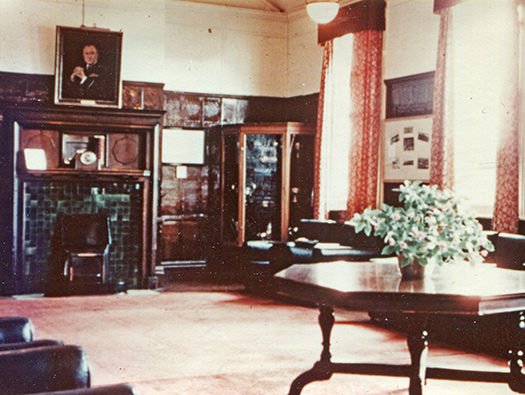
NH Dimmock 1950's
Information
RFC Netheravon, Wiltshire 1913 to 1918
West Camp - Officers Mess
Details
Inside the Officers Mess anti-room between 1950 & close down 31st July 1963.

The last RAF Offices outside the Mess 1963.
RFC Netheravon, Wiltshire 1913 to 1918
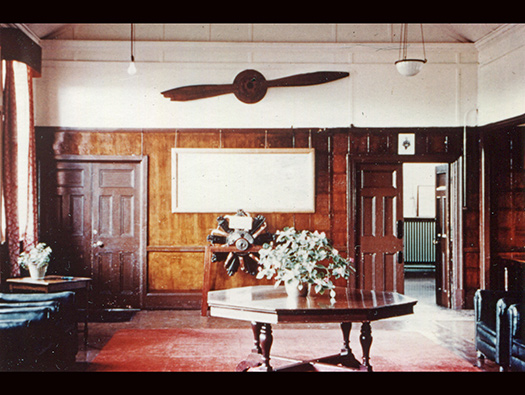
NH Dimmock 1950's
Information
RFC Netheravon, Wiltshire 1913 to 1918
West Camp - Officers Mess
Details
Inside the Officers Mess anti-room.
RFC Netheravon, Wiltshire 1913 to 1918

15 September 2018
Information
RFC Netheravon, Wiltshire 1913 to 1918
West Camp - Officers Quarters for single officers
Details
Officers Quarters for single officers.

Plan.

Pilot.

No.2 Sqn Officers.
RFC Netheravon, Wiltshire 1913 to 1918

September 2019
Information
RFC Netheravon, Wiltshire 1913 to 1918
West Camp - Officers Quarters for single officers
Details
Lovely Georgian designed door
RFC Netheravon, Wiltshire 1913 to 1918

September 2019
Information
RFC Netheravon, Wiltshire 1913 to 1918
West Camp - Officers Quarters for single officers
Details
Officers Quarters for single officers. Enough room for one or two Officers.
RFC Netheravon, Wiltshire 1913 to 1918

2nd. Lt. NH Dimmock 1916 (Lt Kay)
Information
RFC Netheravon, Wiltshire 1913 to 1918
West Camp - Officers Quarters for single officers
Details
Lt Kay taken in 1916 by 2nd Lt. NH Dimmock. They shared a room.
RFC Netheravon, Wiltshire 1913 to 1918

September 2019
Information
RFC Netheravon, Wiltshire 1913 to 1918
West Camp - Officers Quarters for single officers
Details
"Soldier-servant". Every officer was assigned a servant, usually chosen by the officer from among his men. The term batman replaced this in the inter-war years. By the Second World War, only senior officers of the army and Royal Air Force were officially assigned batmen, with junior officers usually sharing the services of one batman among several officers. Batwomen also served in the women's services.
Batman was usually seen as a desirable position. The soldier was exempted from more onerous duties and often got better rations and other favours from his officer. Senior officers' batmen usually received fast promotion to lance-corporal, with many becoming corporals and even sergeants. The position was generally phased out after the war. Officers of the Household Division however still have orderlies, because of the high proportion of ceremonial duties required of them.[5]
In the Royal Navy stewards performed many of the duties of batmen in the other services. Aboard ship, only captains and admirals were assigned personal stewards, with the other officers being served by a pool of officers' stewards. Most vessels carried at least two stewards, with larger vessels carrying considerably more.

Plan.

Private Baldric. Soldier - Servant.

Single Officers Quarters one of nine with the Soldier Servants quarters in the T shaped extension.
RFC Netheravon, Wiltshire 1913 to 1918

September 2019
Information
RFC Netheravon, Wiltshire 1913 to 1918
West Camp - "Soldier-servant's" room.
Details
This is where the servant lived, another name is Batman. He would call the Officer with a cup of tea brewed in this room and would have probably run a bath. Cleaned his shoes and ironed his uniform. You can imagine white cups sat on the dresser shelf. There was also a fire and stove.
RFC Netheravon, Wiltshire 1913 to 1918

14 September 2019
Information
West Camp - RFC Netheravon, Wiltshire 1913 to 1918
West Camp - Sergeants Mess
Details
This was the Sergeants Mess in WW1 where Sergeants could relax and socialise.

Plan.

Sergeant Clauded Wallis Air Mechanic RFC landed France 9th September 1914.

Sergeant Joseph Kemper.
RFC Netheravon, Wiltshire 1913 to 1918

WW1
Information
RFC Netheravon, Wiltshire 1913 to 1918
West Camp - Sergeants Mess
Details
Group of Officers, Sergeants and Men of the RFC at the Concentration.
RFC Netheravon, Wiltshire 1913 to 1918

IWM
Information
RFC Netheravon, Wiltshire 1913 to 1918
West Camp - Sergeants Mess
Details
Sergeants at rest.
RFC Netheravon, Wiltshire 1913 to 1918

1913
Information
RFC Netheravon, Wiltshire 1913 to 1918
West Camp - Regimental Institute
Details
The Regimental Institute is the men's mess. This is where the men could eat, rest, write to loved ones and play games. Gambling was NOT allowed.

Plan.
RFC Netheravon, Wiltshire 1913 to 1918

14 September 2019
Information
RFC Netheravon, Wiltshire 1913 to 1918
West Camp - men's quarters
Details
The men had to put up with a large room and a small room for a corporal who was in charge of the hut. Six AM and they rose up and washed (Abluted), then probably some PT before breakfast and then marched off to work. Marched back for lunch and then back to work for the afternoon. An evening meal and then some time to themselves in the Institute, where they could play games (cards, snooker, etc. [NO gambling]). Lights out at 11.00.

Plan.
RFC Netheravon, Wiltshire 1913 to 1918

14 September 2019
Information
RFC Netheravon, Wiltshire 1913 to 1918
West Camp - men's quarters
Details
Before the camp closed this room was used as a pre-school group and my son was an inmate here.

details

Pre-school days.
RFC Netheravon, Wiltshire 1913 to 1918

14 September 2019
Information
RFC Netheravon, Wiltshire 1913 to 1918
West Camp - men's quarters
Details
No. 4 Squadron was formed at Farnborough in 1912 and moved to Netheravon to make it a two squadron aerodrome. They flew many army co-operation flights throughout the year.

An RFC airman at Netheravon outside his quarters.

No. 4 Squadron had B.E.2's and Breguet biplanes.
RFC Netheravon, Wiltshire 1913 to 1918

WW1
Information
RFC Netheravon, Wiltshire 1913 to 1918
West Camp - men's quarters
Details
Men relaxing officially for the photo. B Flight No.3 Squadron.
RFC Netheravon, Wiltshire 1913 to 1918

00-00-00
Information
RFC Netheravon, Wiltshire 1913 to 1918
West Camp - men's quarters
Details
Relaxing unofficially and playing patience, almost boredom for two of them.
RFC Netheravon, Wiltshire 1913 to 1918

1913 Fuller Amesbury
Information
RFC Netheravon, Wiltshire 1913 to 1918
West Camp - men's quarters
Details
Along here was the Messing office, a reading room, Sergeants Mess and Q.M. stores. And continuing up the road to the Airfield site, East Camp.

Plan.
RFC Netheravon, Wiltshire 1913 to 1918

1913 Unknown
Information
RFC Netheravon, Wiltshire 1913 to 1918
West Camp - Men's Quarters
Details
Unknown as yet Officer outside the men's Quarters.
RFC Netheravon, Wiltshire 1913 to 1918

1913
Information
RFC Netheravon, Wiltshire 1913 to 1918
Camp plan
Details
Continuing down we had five double tin sheds and one triple tin shed, behind were MT sheds for all the transport. An RFC squadron had to be self sufficient in its ability to move around the battle field, so attached to the aircraft component were heavy engineering lorries with lathes and milling machines, heavy and light lorries (tenders), motor cycle and side cars and possibly a few horses. Of them I am not at all sure how many horses were actually used.
RFC Netheravon, Wiltshire 1913 to 1918

1913/14
Information
RFC Netheravon, Wiltshire 1913 to 1918
East Camp
Details
Air photo of the East Camp probably early 1920's showing the first shed is a 1913 twin wooden, side opening shed. This one was used until recently by the parachute club, but fell into dis-repair and was pulled down.

Plan.
RFC Netheravon, Wiltshire 1913 to 1918

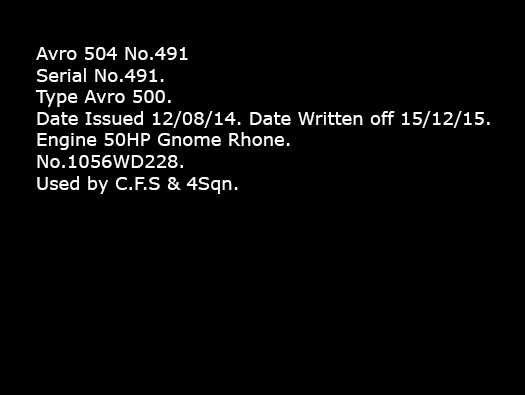
1914 (this could be at Central Flying School Upavon?)
Information
RFC Netheravon, Wiltshire 1913 to 1918
East Camp
Details
1913 side opening shed, right side. Avro 504 No.491 with two RFC officers and two RNAS Officers.

Cross section.

1913 side opening shed.

1913 side opening shed.
RFC Netheravon, Wiltshire 1913 to 1918
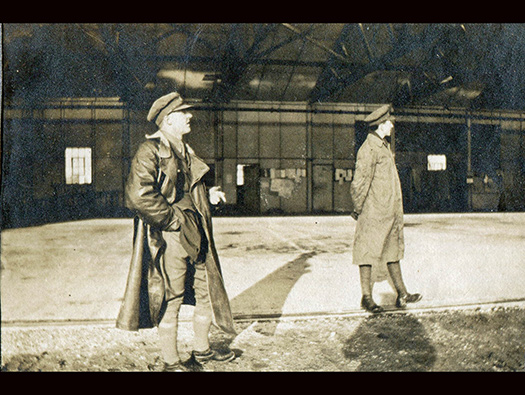
1916 2nd Lt NH Dimmock on right.
Information
RFC Netheravon, Wiltshire 1913 to 1918
East Camp - 2nd Lt NH Dimmock
Details
He was commissioned as a 2nd Lieutenant in the Royal Flying Corps on September 13th 1916. After a month of lectures at Oxford he was posted to the flying school at Netheravon in Wiltshire where he did his first solo on a Maurice Farmen Shorthorn. Pupils in those days had to get to the hangars soon after daybreak, as it was generally too bumpy for flying instruction after about ten o’clock in the morning. (From his memoirs).

Plan.

1913 side opening shed.
RFC Netheravon, Wiltshire 1913 to 1918

From Montrose Facebook page.
Information
RFC Netheravon, Wiltshire 1913 to 1918
East Camp - 1913 Side opening shed
Details
How the shed could have looked at Netheravon.
War was declared on Monday 3rd August 1914 and Netheravon armed guards were placed to guard the aerodrome & aircraft. The aircraft were prepared for war and cockpits were fitted out with racks for rifles and sacks to hold ammunition and the issue of maps. All the squadrons then moved out for Swingate, Dover and then on to France.
Netheravon then went very quiet and it became an annex to C.F.S. Upavon to train Officers that had not yet obtained their aviators certificates.
By October 1914 closed and re opened as No.3 Reserve Aeroplane Company until January 1915 when they moved to Shoreham.
Then Netheravon started the forming of new squadrons under No.4 Wing RFC. This continued until December 1916.

1913 side opening shed.
RFC Netheravon, Wiltshire 1913 to 1918
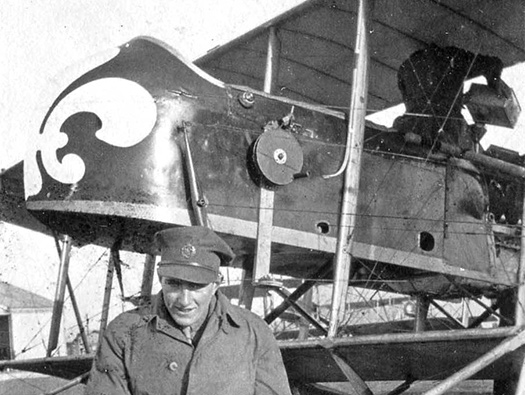
1916 2nd Lt NH Dimmock
Information
RFC Netheravon, Wiltshire 1913 to 1918
East Camp -
Details
2nd Lt NH Dimmock sat on the struts of a Short Horn outside the sheds at Netheravon.
Note the radio aerial cable re wind handle. The cable had a lead weight at its end and had to be wound out to use and wound up to land. If this was not done, the lead weight could do a lot of damage.
2nd Lt NH Dimmock was probably one of the Officers being trained under No.4 Wing where a squadron would be formed, trained and then sent out to France.

2nd Lt NH Dimmock.

Aeroplane radio.
RFC Netheravon, Wiltshire 1913 to 1918

08/11/1916 2nd Lt NH Dimmock
Information
RFC Netheravon, Wiltshire 1913 to 1918
East Camp -
Details
I don't think I mentioned that the two best machines in our flight of four machines were smashed up this week. one was smashed to bits by a chap making a rotten landing, while the other was completely done in by a fellow in 24th Squadron dashing into it on the ground. His machine was also sugared. No one was hurt in the least by either of these little jaunts, our flight being the only thing to suffer (and the government , which has to pay up). However, we have a new machine brought from Farnborough, so it is alright. (Letters from Bob page 67, RFC, Netheravon, Wilts., 8/11/16). He shared a room with 2nd Lt NH Dimmock.

Captain George Pollard Kay, later flight commander No.46 Sqn. RFC. (Letters from Bob).
RFC Netheravon, Wiltshire 1913 to 1918

21 July 2018
Information
RFC Netheravon, Wiltshire 1913 to 1918
East Camp - Guard Room
Details
The East Camp Guard Room. When war was declared this hut would have become a hub of activity as guards were posted out to hangars/sheds all armed and with live ammunition.

Plan.
RFC Netheravon, Wiltshire 1913 to 1918

21 July 2018
Information
RFC Netheravon, Wiltshire 1913 to 1918
East Camp - Guard Room
Details
Inside the East Camp Guard Room.
RFC Netheravon, Wiltshire 1913 to 1918
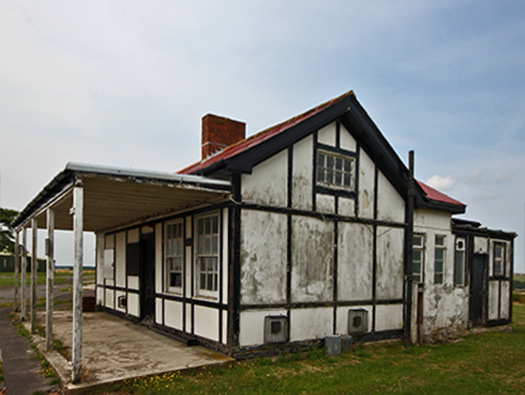
21 July 2018
Information
RFC Netheravon, Wiltshire 1913 to 1918
East Camp - Guard Room
Details
The East Camp Guard Room. Now it is looking even sadder as it has temporary fencing around it.

Temporary fencing.
RFC Netheravon, Wiltshire 1913 to 1918

1950's NH Dimmock
Information
RFC Netheravon, Wiltshire 1913 to 1918
East Camp - HQ
Details
Behind and on the north side of the road is the HQ complex of buildings.

Plan.
RFC Netheravon, Wiltshire 1913 to 1918

1950's NH Dimmock
Information
RFC Netheravon, Wiltshire 1913 to 1918
East Camp - HQ
Details
The X's are the buildings now removed, the large roof below the plane is the 1927 'A' type hangar.
RFC Netheravon, Wiltshire 1913 to 1918
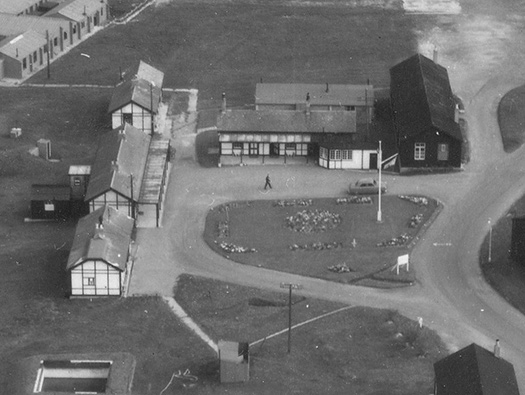
1950's NH Dimmock
Information
RFC Netheravon, Wiltshire 1913 to 1918
East Camp - HQ
Details
Must be spring with all the flowers.

Plan 1913.

Plan 1918.
RFC Netheravon, Wiltshire 1913 to 1918
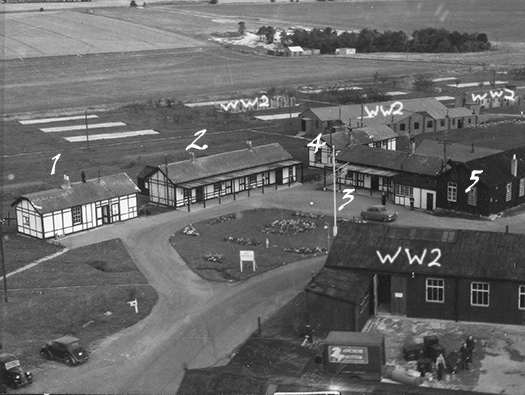
1950's NH Dimmock
Information
RFC Netheravon, Wiltshire 1913 to 1918
East Camp - HQ
Details
From L to R: -
1st - F.O. ?
2nd - Squadron Offices.
3rd - Wing Office.
4th - C.O.'s office.
5th - Transport office.

Plan.
RFC Netheravon, Wiltshire 1913 to 1918

Unknown
Information
RFC Netheravon, Wiltshire 1913 to 1918
East Camp - Unknown picture
Details
Through 1914/1915 & 1916 squadrons were formed. 20, 26, 32, 19, 43, 48 and the numbers go on.
Even No.92 Canadian reserve squadron was formed here.
In April 1918 Netheravon became a Training Depot Station or T.D.S. Many were being formed all over the country and on Salisbury Plain we had Stonehenge, Lake Down, Old Sarum, Boscombe Down, Lopscome Corner and C.F.S still at Upavon. This was the new way of training pilots and squadrons. Netheravon had three T.D.S.'s with 7, 8, and 24. This is when Netheravon also received 10 HP 0/400's.

HP 0/400's.
RFC Netheravon, Wiltshire 1913 to 1918

21 July 2018
Information
RFC Netheravon, Wiltshire 1913 to 1918
East Camp - HQ area.
Details
Squadron Office & Wing HQ.

Plan.
RFC Netheravon, Wiltshire 1913 to 1918

21 July 2018
Information
RFC Netheravon, Wiltshire 1913 to 1918
East Camp - HQ area.
Details
The rear showing the old wooden toilet block.
RFC Netheravon, Wiltshire 1913 to 1918

21 July 2018
Information
RFC Netheravon, Wiltshire 1913 to 1918
East Camp - HQ area.
Details
Bike shed I am afraid is WW2 era.
RFC Netheravon, Wiltshire 1913 to 1918

21 July 2018
Information
RFC Netheravon, Wiltshire 1913 to 1918
East Camp - HQ area.
Details
Lovely bit of old fashion flush.
RFC Netheravon, Wiltshire 1913 to 1918

1962
Information
RFC Netheravon, Wiltshire 1913 to 1918
East Camp - HQ area.
Details
The far end office is now demolished and was the F.O. ?? what ever that was.
AHH!! Flight Office possibly
.
RFC Netheravon, Wiltshire 1913 to 1918

1914/18
Information
RFC Netheravon, Wiltshire 1913 to 1918
East Camp - Aircraft Sheds
Details
Continuing down we had five double tin sheds and one triple tin shed, behind were MT sheds for all the transport. An RFC squadron had to be self sufficient in its ability to move around the battle field, so attached to the aircraft component were heavy engineering lorries with lathes and milling machines, heavy and light lorries (tenders), motor cycle and side cars and possibly a few horses. Of them I am not at all sure how many horses were actually used.

Plan.
RFC Netheravon, Wiltshire 1913 to 1918

1916 NH Dimmock
Information
RFC Netheravon, Wiltshire 1913 to 1918
East Camp - Aircraft Sheds
Details
Behind the Short Horn are some of the sheds.
RFC Netheravon, Wiltshire 1913 to 1918

1950's NH Dimmock
Information
RFC Netheravon, Wiltshire 1913 to 1918
East Camp - Aircraft Sheds
Details
One of the double sheds part of 24 T.D.S.

1918 plan.

Plan.
RFC Netheravon, Wiltshire 1913 to 1918
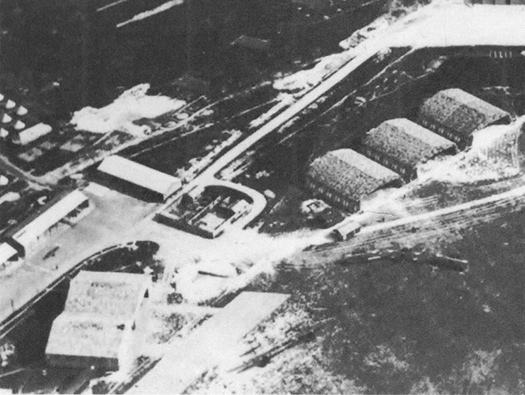
1913
Information
RFC Netheravon, Wiltshire 1913 to 1918
East Camp - Aircraft Sheds
Details
24 T.D.S. and extra Bessonneau hangars. Although a French name, it became a British company and produced thousands of hangars for all over the world wherever the RAF went. RAF Old Sarum used one into the 1980's for their gliding club and Weston-Super-Mare had the remains of one not that many years back.

Bessonneau hangar.

Bessonneau hangar.

Assembling a Bessonneau hangar.
RFC Netheravon, Wiltshire 1913 to 1918

1913
Information
RFC Netheravon, Wiltshire 1913 to 1918
East Camp - MT Sheds
Details
The RFC had a lot of Motor Transport, they had to be able to move the whole squadron at short notice to another aerodrome, which may not have hangarage or any hutting. So the MT carried all aircraft spares, aircraft tentage (each plane had a tent), Mens tents, machinery repair lorries, etc. When war came, this is exactly what they needed and used successfully on the retreat from Mons.
M.T. sheds came it lengths of usually 12 or 13 garages, one may have an inspection pit and there could be an office either in one of the garages or attached at the end. The exact same design continued into WW2 where many stations had multiples of
12/13 garages.

MT.

Repair lorry.

Stow Maries MT section.
RFC Netheravon, Wiltshire 1913 to 1918

Unknown
Information
RFC Netheravon, Wiltshire 1913 to 1918
East Camp - MT Sheds
Details
A tender out side one of the MT sheds at Netheravon. The first RFC vehicles were often gifted or requestioned from commerce. There is a famous photo of a removals lorry in France and the pilots used it to recognise where the airfields had move to in the retreat from Mons.
RFC Netheravon, Wiltshire 1913 to 1918

Stow Maries 19 September 2018
Information
RFC Netheravon, Wiltshire 1913 to 1918
East Camp - MT Sheds
Details
12 Bay MT shed at Stow Maries just like the ones at Old Sarum and Netheravon.

12 Bay plus office at Old Sarum.

13 bay at Old Sarum.
RFC Netheravon, Wiltshire 1913 to 1918

Unknown
Information
RFC Netheravon, Wiltshire 1913 to 1918
East Camp - Clayton Caterpillar Tractor
Details
These tractors were needed to tow around large HP 0/100 & HP 0/500 bombers around, without a tractor you needed 40 Men and the only place where there were 40 men was in a prisoner of war camp and many aerodromes used German prisoners to manoeuvre planes in and out of hangars. These tractors saved a lot of problems.

German POW’s at Dorchester, England.

HP 0/500 being towed on an aerodrome.

HP 0/500. Wing span as big as a Lancaster bomber.
RFC Netheravon, Wiltshire 1913 to 1918

Unknown
Information
RFC Netheravon, Wiltshire 1913 to 1918
East Camp - MT Sheds
Details
Because man power was getting very short, women were taken on do all sorts of jobs in all the armed forces
RFC Netheravon, Wiltshire 1913 to 1918

1913/16
Information
RFC Netheravon, Wiltshire 1913 to 1918
East Camp - A.R.C. Aircraft Sheds
Details
Because more room was needed two large Aircraft Sheds were added later and two Bessonneau hangars.

Plan.
RFC Netheravon, Wiltshire 1913 to 1918

1918
Information
RFC Netheravon, Wiltshire 1913 to 1918
West Camp - East Camp
Details
Final plan of the cap at the end of the war.
RFC Netheravon, Wiltshire 1913 to 1918
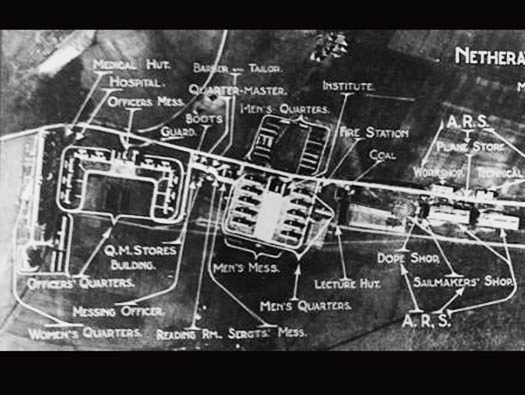

March 1918
Information
RFC Netheravon, Wiltshire 1913 to 1918
Camp - Plan 1918
Details
1913 and the Officers Mess, Sgts, & Men's areas were laid out and the aircraft sheds and a few MT sheds added to the small HQ. Suddenly by 1918 and the height of the war, there was a massive increase in men needed to be trained and a new Mens quarters were added on the north side of the road.
RFC Netheravon, Wiltshire 1913 to 1918
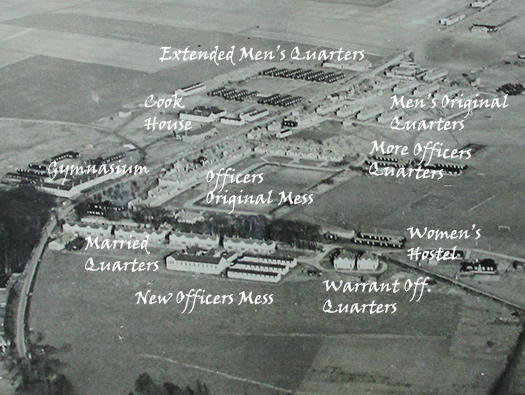
1927 air photo
Information
RFC Netheravon, Wiltshire 1913 to 1918
West Camp - Extended Quarters
Details
The black hutting was built to accommodate the influx of more officers & men between 1916 & 1918 as the RFC & then the RAF expanded rapidly. In front of the married quarters another Officers Mess extension was built with its own quarters.

How the new Officers mess would have looked.

Gymnasium.

Gymnasium from the air.
RFC Netheravon, Wiltshire 1913 to 1918

00-00-00
Information
RFC Netheravon, Wiltshire 1913 to 1918
Details
RAF Netheravon MENU
 Norway (coming soon!)
Norway (coming soon!)
 France
France
 Great Britain
Great Britain















 -
-







































































































































